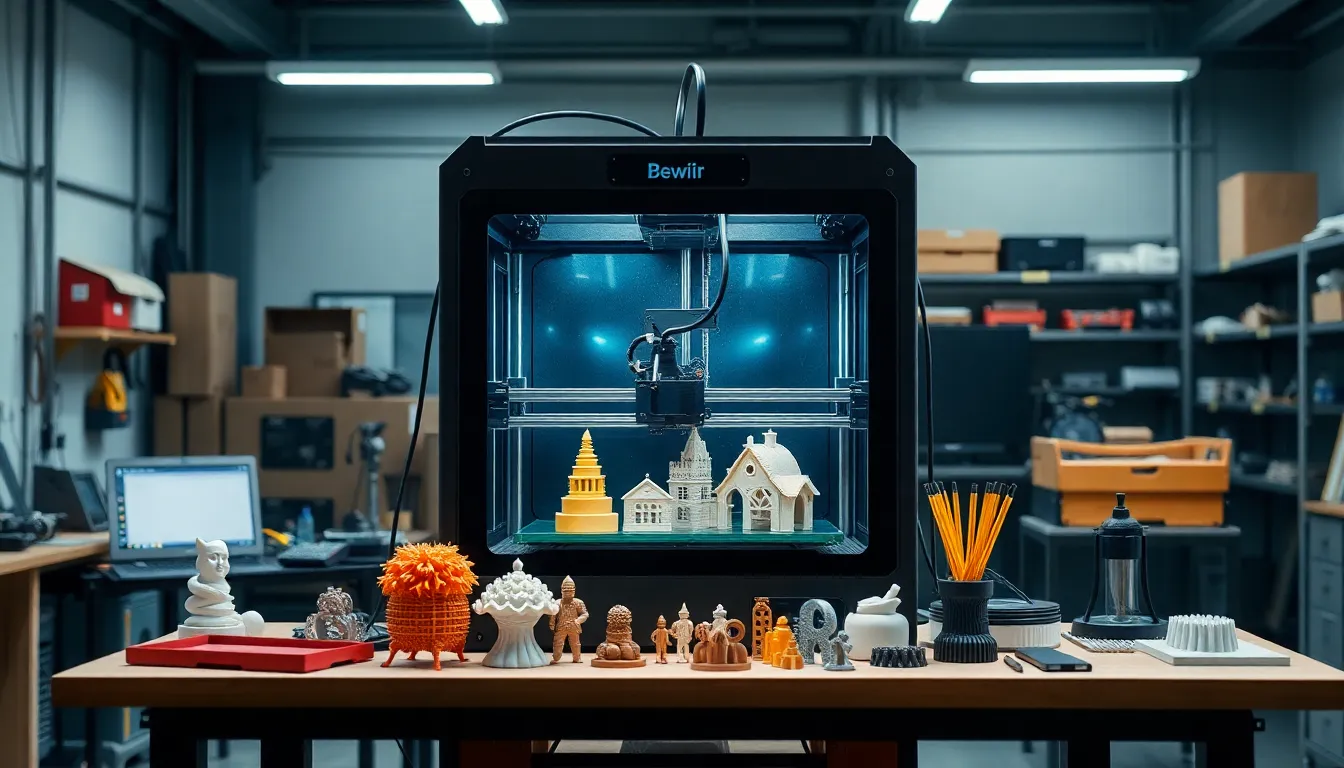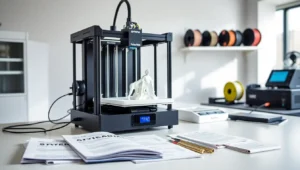In a world where creativity meets technology, 3D printing companies are like the wizards of the modern age, conjuring up everything from intricate prototypes to life-saving medical devices. Imagine being able to print your dream gadget or even a new pair of shoes—without ever leaving your house. Sounds like magic, right? Well, it’s just good old-fashioned innovation at work.
Table of Contents
ToggleOverview of 3D Printing Companies
3D printing companies play a pivotal role in reshaping manufacturing. They enable rapid prototyping, allowing businesses to develop products quickly and efficiently. Numerous industries benefit from these advancements, including aerospace, automotive, healthcare, and consumer goods.
Revolutionary technologies stem from various companies, enhancing printing capabilities. For instance, companies like Stratasys and 3D Systems specialize in industrial-grade printers. MakerBot and Prusa Research focus on providing accessible solutions for hobbyists and education.
Material innovation is another critical aspect of these companies. They offer a range of materials such as thermoplastics, metals, and resins. This variety supports diverse applications, from creating functional parts to artistic endeavors.
The adoption of 3D printing is gaining traction across markets. Many small businesses utilize these technologies to produce custom products quickly. Established enterprises also leverage it for cost savings and streamlined operations.
Challenges persist within the industry, including intellectual property concerns and production scalability. Yet, companies are forging partnerships to address these issues efficiently. Collaboration leads to shared knowledge and improves technology standards.
Market trends indicate growth in both hardware and software sectors. R&D investments continue to drive innovation in printer technologies and materials. By embracing sustainability, companies seek eco-friendly solutions, such as recyclable filaments.
Overall, 3D printing companies contribute significantly to technological advancement. They continue to push boundaries, creating new possibilities for manufacturing and design. Their impact resonates across various industries, shaping the future of how products are made.
Major Players in the Industry

The 3D printing industry features a mix of established leaders and emerging startups, each contributing uniquely to the field and driving innovation forward.
Established Leaders
Stratasys and 3D Systems stand out as established leaders, offering industrial-grade 3D printing solutions. Stratasys excels in producing high-quality additive manufacturing systems, focusing on applications in aerospace and healthcare. 3D Systems provides a diverse range of printers and materials, including advanced metal printing options. These companies play a crucial role in shaping industry standards and technological advancements. Their extensive experience and research capabilities foster ongoing innovation, making them pivotal players in pushing the boundaries of 3D printing.
Emerging Startups
Numerous emerging startups are also making strides in the 3D printing landscape. Companies like Formlabs and Carbon are gaining recognition for their cutting-edge technologies. Formlabs specializes in affordable resin printers designed for dental and jewelry applications. Carbon’s digital light synthesis technology revolutionizes the speed and quality of 3D printed parts. These startups emphasize creativity and cater to niche markets, driving competition and innovation in the industry. As they continue to innovate, they contribute significantly to the overall growth and evolution of 3D printing solutions.
Innovations in 3D Printing
3D printing continues to transform industries with groundbreaking advancements. New materials and technologies drive these changes, expanding capabilities and applications.
Materials and Technology Advancements
Diverse materials enhance the 3D printing landscape. Innovations in thermoplastics, metals, and biocompatible materials enable strong, lightweight designs. Companies focus on developing filaments that support varied applications, from complex geometries to high-strength prototypes. Technologies such as multi-material printing allow for customization, producing intricate products in a single run. Automated post-processing techniques streamline manufacturing, ensuring higher efficiency and precision. Producers increasingly invest in research and development to improve material properties, promoting sustainability and reducing waste.
Applications Across Industries
3D printing finds applications across numerous industries. The aerospace sector utilizes it for lightweight components that improve fuel efficiency. In healthcare, custom implants and tailored prosthetics enhance patient outcomes. Automotive companies leverage 3D printing for rapid prototyping and manufacturing of replacement parts, reducing downtime. Consumer goods benefit from personalized products, with brands embracing customization to meet individual preferences. Education institutions incorporate 3D printing into curricula, fostering creativity and innovation among students. Each of these sectors demonstrates the technology’s ability to drive progress and address specific needs effectively.
Challenges Facing 3D Printing Companies
3D printing companies face numerous challenges in their quest for innovation and success. Key obstacles include regulatory hurdles and market competition, both of which significantly impact growth and development.
Regulatory Hurdles
Navigating regulatory frameworks can impede progress for 3D printing companies. Compliance with safety standards and certifications often varies by industry, which complicates product development. Every country enforces its own regulations, causing confusion and delays for manufacturers. Regulatory bodies may impose restrictions on materials used in production, particularly in sectors like aerospace and healthcare. Adhering to these regulations demands time and resources. Companies that manage to stay ahead often maintain a competitive edge, fostering trust among consumers and stakeholders.
Market Competition
Intense market competition challenges 3D printing companies to innovate consistently. Numerous players exist within the industry, ranging from established giants like Stratasys and 3D Systems to nimble startups like Formlabs and Carbon. Each competitor seeks to capture market share by offering unique capabilities or lower prices. Differentiation becomes crucial in this crowded landscape. Companies frequently invest in research and development to improve technology and expand material offerings. Staying relevant requires constant adaptation to emerging trends and shifting consumer demands, as each company strives to lead the way in a rapidly evolving market.
Future Prospects for 3D Printing Companies
Growth in 3D printing technology promises substantial opportunities for companies in the sector. Manufacturers increasingly rely on additive processes to optimize production efficiency and reduce waste. Emerging applications in medical device creation and aerospace components highlight this shift.
Innovative startups continue to enter the market, bringing fresh ideas and unique solutions. Companies like Formlabs and Carbon are focusing on specialized niches, driving advancements in resin-based and metal printing technologies. Established firms like Stratasys and 3D Systems remain competitive by evolving their product lines and enhancing service offerings.
Partnerships between companies also play a significant role in expanding capabilities. Collaborative efforts help address intellectual property challenges and enhance compliance with regulatory frameworks. This trend indicates a willingness to adapt and innovate collectively across the industry.
Market reports from research firms project steady growth through 2025, driven by increased investment in research and development. Consumer demand for customized products continues to rise, fueling the expansion of 3D printing applications. Adjustments to eco-friendly practices allow for sustainable progress, aligning with global environmental initiatives.
Efficiency improvements in software solutions and automation technologies further optimize production processes. Shifts toward subscription models and cloud-based services create avenues for accessible 3D printing for small businesses and educational institutions.
Competition remains intense, prompting firms to prioritize differentiation strategies. Ongoing investments in advanced materials such as biodegradable polymers and high-strength composites enhance product offerings. Adapting to market needs while navigating challenges will define the success of 3D printing companies moving forward.
The landscape of 3D printing companies is evolving rapidly as they harness innovation to meet diverse market demands. As technology advances and materials improve, these companies are redefining manufacturing processes and product development. The ongoing collaboration between established firms and emerging startups is crucial for addressing challenges and enhancing capabilities.
With a focus on sustainability and efficiency, the future looks promising for 3D printing. Companies that adapt to changing consumer needs and invest in research and development will thrive in this competitive environment. As the industry continues to grow, the potential for groundbreaking applications remains limitless, shaping the world of manufacturing and design for years to come.





